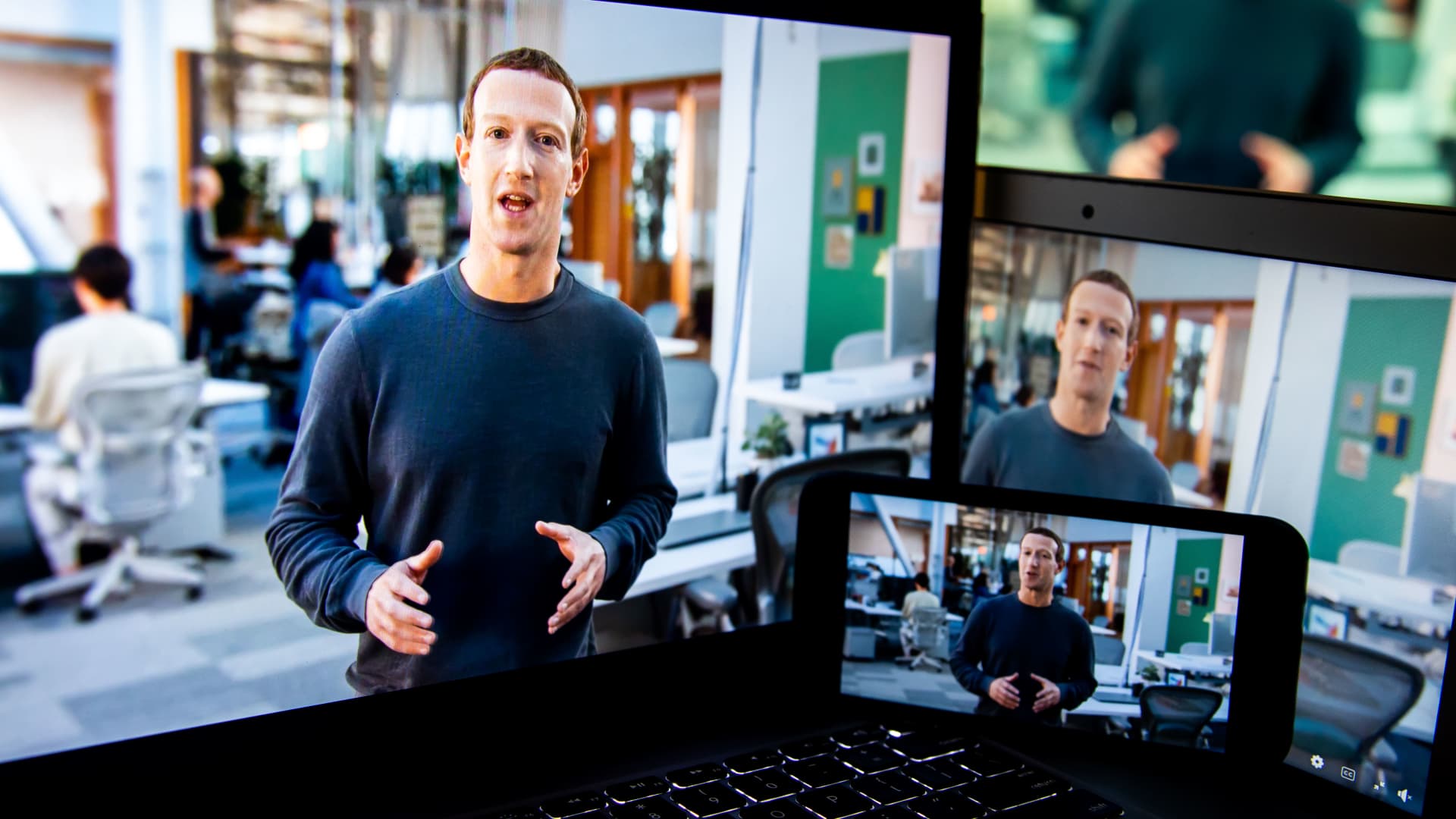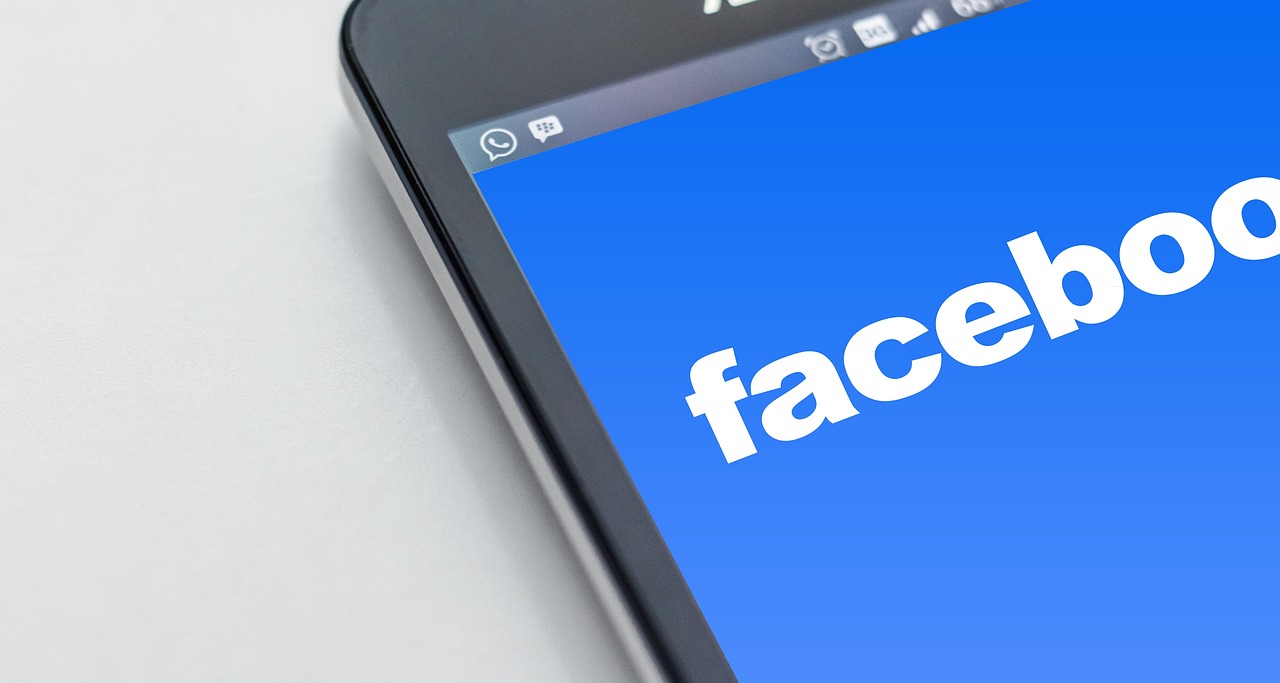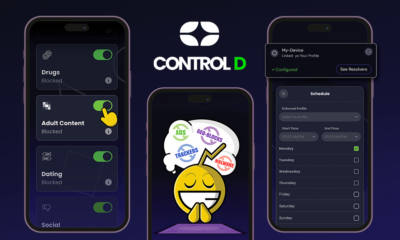Meta suffered a major Facebook ad glitch, clients asking about refunds

Mark Zuckerberg, chief executive officer of Meta Platforms Inc., speaks during the virtual Meta Connect event in New York, US, on Tuesday, Oct. 11, 2022.
Michael Nagle | Bloomberg | Getty Images
Over the weekend, Alex Gorlick experienced what he called the worst Facebook glitch he’s seen in the decade he’s worked in digital advertising.
Gorlick, the CEO of marketing agency Intensify, checked in on one of his client’s accounts on Sunday, and noticed that it had spent 90% of its daily Facebook ad budget by 9 a.m. That meant it had only 10% left for the remaining 15 hours of the day.
He then found that the problem was widespread, spanning his entire customer base. Gorlick said that all those advertisers had essentially just wasted most of their money for the day, spending roughly triple the amount they normally would to acquire a customer.
“The results were horrendous,” Gorlick told CNBC. “It’s the biggest malfunction I’ve ever seen on Facebook ads.”
For brands that are already lowering ad costs to manage through a sluggish economy and a mobile ad market that no longer allows for targeting based on user data, Facebook’s miscue is more than just an unfortunate blip. In low-margin industries, where every dollar counts, it can turn a profitable weekend into a big loser, while also raising further questions about the reliability of Facebook’s ad systems.
A spokesperson for Facebook parent Meta acknowledged there was an ad glitch but declined to provide details or an explanation as to why it happened.
“A technical issue that has now been resolved caused ad delivery issues for some advertisers,” the spokesperson said.
How Facebook ad auctions work
In a typical Facebook online ad auction, a company can allocate a certain amount of money to run ads on the social media service over the course of a day to maximize how many eyeballs see the promotion. It appears that on Sunday the Facebook ad system bundled many more ads than normal into the morning hours, resulting in a highly inefficient day.
Data analytics and marketing firm Varos provided data showing that, of the more than 3,000 ecommerce and direct-to-consumer companies that use its technology, the software bug caused a majority of them to experience a rise in cost per thousand impressions, or what those in the industry call CPMs.
About 36% of companies were “very significantly impacted” by the bug, meaning their CPMs at least doubled, Varos said. Varos CEO Yarden Shaked said another third of companies experienced “significant increases but not like bonkers.”
Shaked said the glitch resulted in a “bidding war for nothing.” He compared it to Costco selling a random toaster that suddenly garnered so much demand that the price spiked way beyond market value.
“Everyone came in in the middle of the night for some reason and started a bidding war over that old toaster,” Shaked said. “You know, it’s completely ridiculous.”
Data about the glitch provided by the advertising technology firm Proxima on 108 companies also revealed that these firms spent their “entire day’s budget in the first few hours of the day,” the company said.
Companies that implemented cost caps, or limits on their advertising campaigns, were not impacted by the glitch, Proxima noted. When companies turned off their ad campaigns because of the bug, some bigger brands took advantage and were able to run successful Facebook ad campaigns throughout the day because of a lack of competition.
Additionally, the Facebook ad bug impacted companies running ads tied to Earth Day.
“The fact that it was Earth Day on Saturday, April 22nd meant that brands running sales for Earth Day were the most impacted like organic, eco-friendly brands focused on Earth Day as a key selling period,” the company said.
Barry Hott, a performance marketing consultant, said that at the time of the bug, the situation for companies running Facebook ads seemed “pretty massive, very painful.”
In retrospect, however, Hott believes the overall impact of the ad error might be “pretty small,” considering in the grand scheme of things, companies occasionally deal with big Meta ad errors that impact their campaigns.
Hott noted that Facebook experienced a major ad glitch a day before Black Friday in 2020 as well as another similar bug earlier that summer.
Refunds?
The main issue for advertisers will be whether they get refunds from Meta because of the glitch, industry experts said.
The Meta spokesperson said the company is “conducting a detailed analysis that assesses opportunities for refunds.”
“We have more information on the refunds process here,” the spokesperson added in a statement.
Because of the glitch, “a bunch of advertisers and business owners had a really s—y day,” Hott said, adding that they will have a “crappy week” as they wonder if they will get refunds and if they do, will it be the full amount they believe they should be owed or chump change.
He recommends that if advertisers have access to a Meta customer support representative — a part of Meta that has been hit by layoffs — they need to ask frequently about refunds, or risk being ignored. Because retailers often make business decisions like how many products they should order or sell based
on their online advertisements, the software glitch could also impact other areas in a company’s business than just merely an increase to their CPMs.
“Basically, no one at the company is going to care about this problem if nobody’s saying anything about it, so they kind of count on advertisers to forget about this in a week or two weeks,” Hott said. “I tell everyone— I’ve had to do this myself — when these issues happen, you know, make a big stink about it.”
Watch: Elon Musk inspired Zuckerberg to reduce Meta’s headcount
Facebook Faces Yet Another Outage: Platform Encounters Technical Issues Again

Uppdated: It seems that today’s issues with Facebook haven’t affected as many users as the last time. A smaller group of people appears to be impacted this time around, which is a relief compared to the larger incident before. Nevertheless, it’s still frustrating for those affected, and hopefully, the issues will be resolved soon by the Facebook team.
Facebook had another problem today (March 20, 2024). According to Downdetector, a website that shows when other websites are not working, many people had trouble using Facebook.
This isn’t the first time Facebook has had issues. Just a little while ago, there was another problem that stopped people from using the site. Today, when people tried to use Facebook, it didn’t work like it should. People couldn’t see their friends’ posts, and sometimes the website wouldn’t even load.
Downdetector, which watches out for problems on websites, showed that lots of people were having trouble with Facebook. People from all over the world said they couldn’t use the site, and they were not happy about it.
When websites like Facebook have problems, it affects a lot of people. It’s not just about not being able to see posts or chat with friends. It can also impact businesses that use Facebook to reach customers.
Since Facebook owns Messenger and Instagram, the problems with Facebook also meant that people had trouble using these apps. It made the situation even more frustrating for many users, who rely on these apps to stay connected with others.
During this recent problem, one thing is obvious: the internet is always changing, and even big websites like Facebook can have problems. While people wait for Facebook to fix the issue, it shows us how easily things online can go wrong. It’s a good reminder that we should have backup plans for staying connected online, just in case something like this happens again.
Christian family goes in hiding after being cleared of blasphemy

LAHORE, Pakistan — A court in Pakistan granted bail to a Christian falsely charged with blasphemy, but he and his family have separated and gone into hiding amid threats to their lives, sources said.
Haroon Shahzad, 45, was released from Sargodha District Jail on Nov. 15, said his attorney, Aneeqa Maria. Shahzad was charged with blasphemy on June 30 after posting Bible verses on Facebook that infuriated Muslims, causing dozens of Christian families in Chak 49 Shumaali, near Sargodha in Punjab Province, to flee their homes.
Lahore High Court Judge Ali Baqir Najfi granted bail on Nov. 6, but the decision and his release on Nov. 15 were not made public until now due to security fears for his life, Maria said.
Shahzad told Morning Star News by telephone from an undisclosed location that the false accusation has changed his family’s lives forever.
“My family has been on the run from the time I was implicated in this false charge and arrested by the police under mob pressure,” Shahzad told Morning Star News. “My eldest daughter had just started her second year in college, but it’s been more than four months now that she hasn’t been able to return to her institution. My other children are also unable to resume their education as my family is compelled to change their location after 15-20 days as a security precaution.”
Though he was not tortured during incarceration, he said, the pain of being away from his family and thinking about their well-being and safety gave him countless sleepless nights.
“All of this is due to the fact that the complainant, Imran Ladhar, has widely shared my photo on social media and declared me liable for death for alleged blasphemy,” he said in a choked voice. “As soon as Ladhar heard about my bail, he and his accomplices started gathering people in the village and incited them against me and my family. He’s trying his best to ensure that we are never able to go back to the village.”
Shahzad has met with his family only once since his release on bail, and they are unable to return to their village in the foreseeable future, he said.
“We are not together,” he told Morning Star News. “They are living at a relative’s house while I’m taking refuge elsewhere. I don’t know when this agonizing situation will come to an end.”
The Christian said the complainant, said to be a member of Islamist extremist party Tehreek-e-Labbaik Pakistan and also allegedly connected with banned terrorist group Lashkar-e-Jhangvi, filed the charge because of a grudge. Shahzad said he and his family had obtained valuable government land and allotted it for construction of a church building, and Ladhar and others had filed multiple cases against the allotment and lost all of them after a four-year legal battle.
“Another probable reason for Ladhar’s jealousy could be that we were financially better off than most Christian families of the village,” he said. “I was running a successful paint business in Sargodha city, but that too has shut down due to this case.”
Regarding the social media post, Shahzad said he had no intention of hurting Muslim sentiments by sharing the biblical verse on his Facebook page.
“I posted the verse a week before Eid Al Adha [Feast of the Sacrifice] but I had no idea that it would be used to target me and my family,” he said. “In fact, when I came to know that Ladhar was provoking the villagers against me, I deleted the post and decided to meet the village elders to explain my position.”
The village elders were already influenced by Ladhar and refused to listen to him, Shahzad said.
“I was left with no option but to flee the village when I heard that Ladhar was amassing a mob to attack me,” he said.
Shahzad pleaded with government authorities for justice, saying he should not be punished for sharing a verse from the Bible that in no way constituted blasphemy.
Similar to other cases
Shahzad’s attorney, Maria, told Morning Star News that events in Shahzad’s case were similar to other blasphemy cases filed against Christians.
“Defective investigation, mala fide on the part of the police and complainant, violent protests against the accused persons and threats to them and their families, forcing their displacement from their ancestral areas, have become hallmarks of all blasphemy allegations in Pakistan,” said Maria, head of The Voice Society, a Christian paralegal organization.
She said that the case filed against Shahzad was gross violation of Section 196 of the Criminal Procedure Code (CrPC), which states that police cannot register a case under the Section 295-A blasphemy statute against a private citizen without the approval of the provincial government or federal agencies.
Maria added that Shahzad and his family have continued to suffer even though there was no evidence of blasphemy.
“The social stigma attached with a blasphemy accusation will likely have a long-lasting impact on their lives, whereas his accuser, Imran Ladhar, would not have to face any consequence of his false accusation,” she said.
The judge who granted bail noted that Shahzad was charged with blasphemy under Section 295-A, which is a non-cognizable offense, and Section 298, which is bailable. The judge also noted that police had not submitted the forensic report of Shahzad’s cell phone and said evidence was required to prove that the social media was blasphemous, according to Maria.
Bail was set at 100,000 Pakistani rupees (US $350) and two personal sureties, and the judge ordered police to further investigate, she said.
Shahzad, a paint contractor, on June 29 posted on his Facebook page 1 Cor. 10:18-21 regarding food sacrificed to idols, as Muslims were beginning the four-day festival of Eid al-Adha, which involves slaughtering an animal and sharing the meat.
A Muslim villager took a screenshot of the post, sent it to local social media groups and accused Shahzad of likening Muslims to pagans and disrespecting the Abrahamic tradition of animal sacrifice.
Though Shahzad made no comment in the post, inflammatory or otherwise, the situation became tense after Friday prayers when announcements were made from mosque loudspeakers telling people to gather for a protest, family sources previously told Morning Star News.
Fearing violence as mobs grew in the village, most Christian families fled their homes, leaving everything behind.
In a bid to restore order, the police registered a case against Shahzad under Sections 295-A and 298. Section 295-A relates to “deliberate and malicious acts intended to outrage religious feelings of any class by insulting its religion or religious beliefs” and is punishable with imprisonment of up to 10 years and fine, or both. Section 298 prescribes up to one year in prison and a fine, or both, for hurting religious sentiments.
Pakistan ranked seventh on Open Doors’ 2023 World Watch List of the most difficult places to be a Christian, up from eighth the previous year.
Morning Star News is the only independent news service focusing exclusively on the persecution of Christians. The nonprofit’s mission is to provide complete, reliable, even-handed news in order to empower those in the free world to help persecuted Christians, and to encourage persecuted Christians by informing them that they are not alone in their suffering.
Free Religious Freedom Updates
Join thousands of others to get the FREEDOM POST newsletter for free, sent twice a week from The Christian Post.
Individual + Team Stats: Hornets vs. Timberwolves
CHARLOTTE HORNETS MINNESOTA TIMBERWOLVES You can follow us for future coverage by liking us on Facebook & following us on X: Facebook – All Hornets X – …
Source link
-

 PPC4 days ago
PPC4 days ago19 Best SEO Tools in 2024 (For Every Use Case)
-

 PPC7 days ago
PPC7 days ago4 New Google Ads Performance Max Updates: What You Need to Know
-
SEARCHENGINES6 days ago
Daily Search Forum Recap: April 16, 2024
-

 MARKETING6 days ago
MARKETING6 days agoWill Google Buy HubSpot? | Content Marketing Institute
-

 SEO6 days ago
SEO6 days agoGoogle Clarifies Vacation Rental Structured Data
-

 MARKETING6 days ago
MARKETING6 days agoStreamlining Processes for Increased Efficiency and Results
-
SEARCHENGINES5 days ago
Daily Search Forum Recap: April 17, 2024
-

 PPC7 days ago
PPC7 days agoHow to Collect & Use Customer Data the Right (& Ethical) Way














